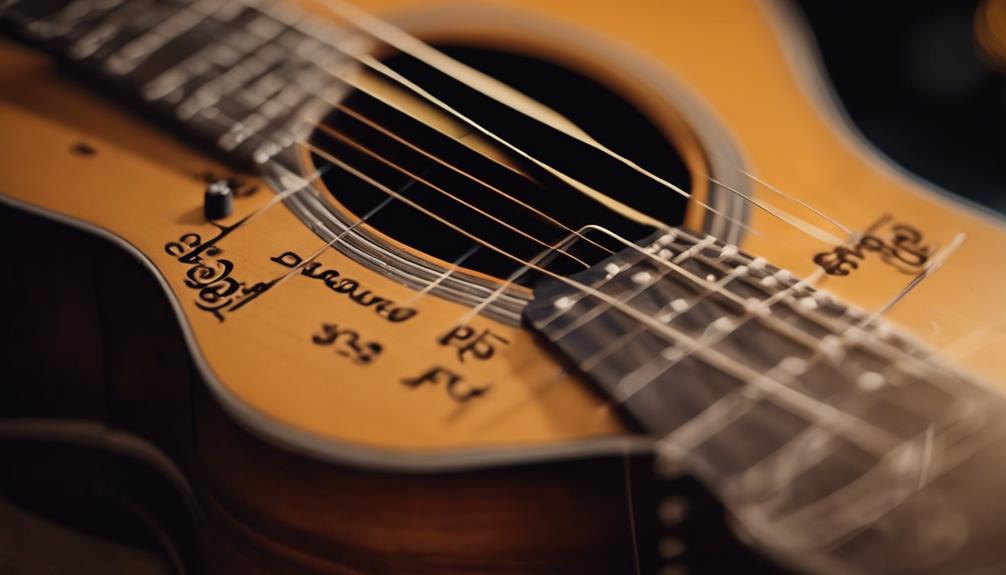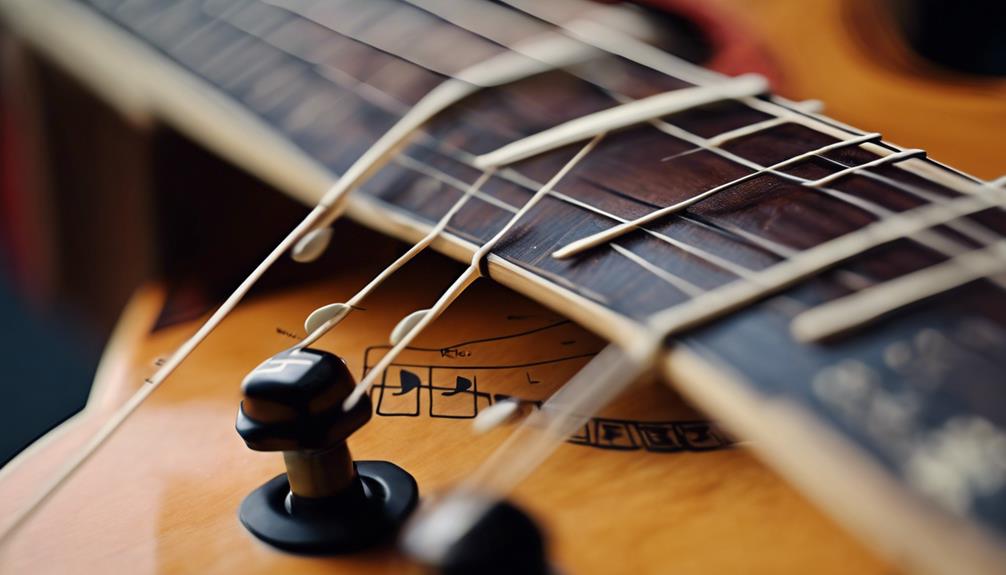Starting with guitar scales can feel overwhelming, but it’s an essential step for any beginner. You’ll find that scales not only provide a foundation for music theory but also greatly enhance your finger strength and dexterity.
Knowing scales like the E minor pentatonic or the C major opens up a world of improvisation and musical expression. But where should you begin, and how can you systematically incorporate these into your practice?
Let’s explore some essential scales and techniques to help you navigate this fundamental aspect of guitar playing.
TL-DR
- Practicing guitar scales enhances finger strength and dexterity.
- Major, minor, and pentatonic scales are foundational for music theory and improvisation.
- The E minor pentatonic scale is ideal for beginners, especially in rock and blues.
- Learning the C major scale helps understand other scales and key signatures.
- The G major scale is essential for improving finger dexterity and fretboard knowledge.
What Are Guitar Scales?

Guitar scales are sequences of notes you play in a specific order to create melodies, solos, and chord progressions. For beginners, understanding these scales is an essential step in your musical journey. Scales like major, minor, and pentatonic form the building blocks of music. By learning these, you’ll gain a deeper understanding of how music works and how to navigate the fretboard.
When you practice scales, you’re not just memorizing sequences of notes played in order; you’re also developing finger strength and dexterity. This is vital for playing more complex pieces and for improvisation. For instance, the pentatonic scale is particularly popular in rock and blues due to its simple, yet versatile, structure.
Each type of scale has its own unique sound and application. Major scales tend to sound happy and bright, while minor scales often carry a more somber or emotional tone. As you explore these scales, you’ll start to see how they guide your musical exploration and composition.
Mastering scales opens up a world of improvisation, allowing you to express yourself creatively and musically with confidence.
Why Learn Guitar Scales?
Mastering guitar scales is vital for developing your technique and understanding the instrument’s full potential. By learning scales, you improve your finger strength and dexterity, making it easier to navigate the fretboard and play more complex pieces.
For beginners, guitar scales lay the foundation for recognizing notes and their positions across different pitches and octaves.
Practicing scales also helps develop your musical ear, enabling you to create melodies and understand music theory better. When you know scales, you’re not just memorizing patterns; you’re gaining a framework that supports improvisation and soloing. This is essential for any guitarist who wants to express themselves freely and creatively.
Moreover, understanding scales is key to revealing the fretboard’s mysteries. You’ll find that playing across various octaves becomes second nature, and you’ll be able to anticipate which notes will sound harmonious in any given context. This knowledge is invaluable for both composing and performing.
In short, learning beginner guitar scales is a fundamental step toward becoming a well-rounded musician. It opens up a world of musical possibilities and enhances your overall guitar playing skills to a great extent.
E Minor Pentatonic

Let’s start with the basic pattern of the E minor pentatonic scale, which you’ll find is simple and intuitive.
As you get comfortable with this pattern, you’ll see how it’s commonly used in rock and blues solos.
Practicing this scale also builds your fret-hand strength and improves your ear for different pitches.
Basic Scale Pattern
To start playing the E Minor Pentatonic scale, focus on the five essential notes: E, G, A, B, and D. This scale is a cornerstone in rock and blues music, making it a great choice for beginner guitarists. By practicing this scale, you’ll build finger strength and dexterity, which are important for playing more complex pieces later on.
Begin by learning the basic scale shapes on the fretboard. You can practice the scale ascending or descending, which helps familiarize you with the note positions and intervals. As you practice scales regularly, your ability to improvise will improve significantly. This is particularly beneficial in blues music, where the E Minor Pentatonic scale is commonly used for solos and riffs.
Understanding the structure of the E Minor Pentatonic scale will also enhance your musical vocabulary. Don’t hesitate to incorporate bends, slides, and hammer-ons into your practice. These techniques add expression and dynamics, making your playing more interesting and engaging.
Common Scale Applications
Wondering how you can apply the E Minor Pentatonic scale to your playing? This scale is a cornerstone for beginners diving into rock and blues music. With just five essential notes, it’s straightforward to learn and perfect for soloing. You’ll find it featured in numerous iconic songs by artists like AC/DC and Link Wray, making it a must-know for any aspiring guitarist.
Practicing the E Minor Pentatonic scale doesn’t just help you nail solos; it also builds your finger strength and dexterity. Mastering this scale will make your fingers more agile and familiar with the fretboard, important skills for any guitarist. The more you practice, the more comfortable you’ll become moving up and down the neck.
Developing a musical ear is another significant benefit. As you get more familiar with the E Minor Pentatonic scale, you’ll start recognizing its sound in songs and using it to create your own alluring melodies. This will make your improvisations and solos more engaging and musically rich.
A Minor Pentatonic
The A minor pentatonic scale, consisting of the notes A, C, D, E, and G, is a fundamental tool for creating expressive solos in rock, blues, and pop music. Its simplicity and effectiveness make it a go-to choice for many guitarists when improvising. You’ll find that the minor pentatonic scale’s structure lends itself well to the emotional and dynamic range required in these genres. Songs like ‘Stairway to Heaven‘ by Led Zeppelin showcase its versatility and power.
To master the A minor pentatonic, practice it in various positions on the fretboard. This will help you move fluidly across the neck, enhancing your improvisation skills. Start by playing it in the fifth position, then slowly explore different areas of the fretboard. This approach not only builds versatility but also deepens your understanding of the guitar’s layout.
When you’re comfortable, try creating your own solos. The A minor pentatonic is forgiving and allows you to experiment without hitting too many sour notes. Its adaptability is perfect for crafting memorable lines in rock, blues, and pop. Get involved, and let the minor pentatonic scale unleash your creative potential.
C Major Scale

Now, let’s look at the C Major Scale.
You’ll learn the notes C, D, E, F, G, A, and B and how to position your fingers on the fretboard.
We’ll also cover some practice techniques to help you master this essential scale.
Notes in C Major
If you’re just starting out, the C Major scale is perfect because it’s made up of the simple notes C, D, E, F, G, A, and B, without any sharps or flats. This simplicity makes it one of the most beginner-friendly scales to learn. The notes in C Major serve as a foundation for understanding other scales, such as the G Major Scale, which introduces one sharp.
When you start with the C Major scale, you’re laying the groundwork for more complex scales like major and minor scales and even pentatonic scales. The C Major scale’s notes are straightforward and free from the complications of sharps or flats, which can be overwhelming for beginners. As you become more comfortable with these notes, you’ll find it easier to shift to other keys and scales, including the key of G.
Understanding the notes in C Major also helps you create melodies and chord progressions. It’s a fundamental skill that will support your growth as a guitarist. By mastering this scale, you’ll enhance your musical versatility and be better prepared to tackle more advanced concepts in the future.
Basic Finger Positioning
When you’re practicing the C Major scale, focus on proper finger positioning to build a strong foundation. Start by placing your index finger on the 1st fret, your middle finger on the 2nd fret, and your ring finger on the 3rd fret. Make sure you’re also using the open strings, as the C Major scale in open position will help you get comfortable playing both fretted and open notes.
The C Major scale is your first step in understanding how scales are organized sequences of notes. Ascend and descend the scale slowly to build finger strength and muscle memory. This regular practice will improve your finger agility and overall familiarity with the fretboard.
You might’ve heard about other scales like the G minor pentatonic or the major pentatonic scale. While they’re important, starting with the C Major scale is something every guitarist needs to know. It’s a foundational scale that will make learning these other scales easier down the road.
Practice Techniques Tips
To maximize your practice with the C Major scale, integrate specific techniques that enhance your finger strength and agility. Start by ascending and descending the scale smoothly without pauses. Focus on the whole step and half steps intervals between the notes: C-D (whole), D-E (whole), E-F (half), F-G (whole), G-A (whole), A-B (whole), and B-C (half). This will sharpen your understanding of major scales and their construction.
While practicing scales, keep your fingers close to the higher frets, which improves positioning and reduces unnecessary movement. Additionally, emphasize the root notes (C) to stay grounded in the scale. You can use a backing track for a more dynamic practice session, making the experience more engaging and helping you stay in time.
Incorporate variations like the G major pentatonic or minor pentatonic scale to add diversity to your practice. These essential guitar scales share similarities with the C Major scale and broaden your musical vocabulary.
As you become comfortable with the C Major scale, explore modal scales and workouts based on it. This advanced practice will deepen your understanding and enhance your ability to create melodies and chords.
G Major Scale
Kicking off your journey with the G major scale, you’ll find it consists of the notes G, A, B, C, D, E, and F#. This scale is fundamental in Western music and is an excellent starting point for beginners. By learning the G major scale, you’ll practice organized sequences of notes that are played in an ascending and descending manner. The root note is G, and from there, you’ll move through seven notes, with one half step between the third and fourth notes, as well as the seventh and eighth notes.
To get the most out of the G major scale, consider these key benefits:
- Improves finger dexterity and fretboard knowledge
- Helps understand key signatures and chord progressions
- Provides a foundation for creating melodies and solos
- Commonly used across various musical genres
- Essential for improvisation in the key of G
The G major scale is a scale that you’ll need to master if you want to play in different keys and understand the structure of Western music. By practicing this scale regularly, you’ll open up a world of musical possibilities and enhance your overall guitar playing skills.
Next up learn about guitar techniques and skills in this guide.
